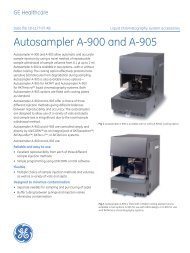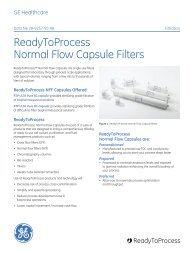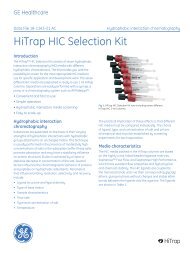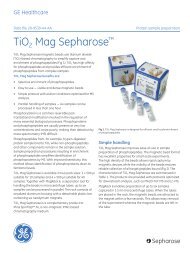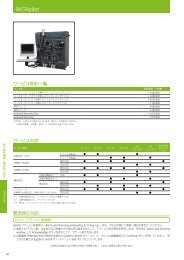A new IMAC medium for scaling up purification of Histidine-tagged ...
A new IMAC medium for scaling up purification of Histidine-tagged ...
A new IMAC medium for scaling up purification of Histidine-tagged ...
Create successful ePaper yourself
Turn your PDF publications into a flip-book with our unique Google optimized e-Paper software.
GE Healthcare<br />
A <strong>new</strong> <strong>IMAC</strong> <strong>medium</strong> <strong>for</strong><br />
<strong>scaling</strong> <strong>up</strong> <strong>purification</strong> <strong>of</strong><br />
<strong>Histidine</strong>-<strong>tagged</strong> proteins<br />
Jon Lundqvist, Lars C Andersson, Ann Bergh, Ellinor Ancker, Marianne Carlsson,<br />
Anna Heijbel, Helena Lindgren, Karin Torstenson and Katarina Öberg<br />
GE Healthcare, SE-751 84 Uppsala, Sweden<br />
Introduction<br />
The (<strong>Histidine</strong>) 6<br />
-tag has become the most used affinity tag<br />
due to its small size, strong metal ion binding and ability to<br />
bind under denaturing conditions. Immobilized Metal Ion<br />
Affinity Chromatography (<strong>IMAC</strong>) with Ni 2+ is the standard<br />
method <strong>for</strong> purifying histidine-<strong>tagged</strong> proteins. Here, a<br />
<strong>new</strong> <strong>medium</strong> optimized <strong>for</strong> <strong>scaling</strong> <strong>up</strong> <strong>purification</strong>,<br />
Ni Sepharose 6 Fast Flow, is presented.<br />
Ni Sepharose 6 Fast Flow<br />
• Pre-charged with Ni 2+ and available in different<br />
<strong>for</strong>mats, including pre-packed 1-ml and 5-ml<br />
HisTrap FF and 20-ml HisPrep FF 16/10 columns.<br />
• The bead-size (~90-µm) makes it possible to scale<strong>up</strong><br />
<strong>purification</strong> maintaining high target protein<br />
concentration in the eluted peak.<br />
• Compatible with a wide range <strong>of</strong> buffers and<br />
additives, including denaturants, detergents and<br />
reducing agents.<br />
Conclusions<br />
The following results were obtained with<br />
Ni Sepharose 6 Fast Flow:<br />
• Easy to scale-<strong>up</strong> <strong>purification</strong> from 1-ml via<br />
5-ml to 20-ml columns.<br />
• Low leakage <strong>of</strong> Ni 2+ and compatibility with the<br />
reducing agent DTT.<br />
• A number <strong>of</strong> <strong>Histidine</strong>-<strong>tagged</strong> proteins from<br />
different:<br />
– expression systems<br />
– expression levels<br />
– with different M r<br />
– with different lengths <strong>of</strong> the <strong>Histidine</strong>-tag<br />
were easily purified.
Material and Methods<br />
Chromatography conditions were, unless otherwise stated:<br />
Medium: Ni Sepharose 6 Fast Flow pre-packed in 1-ml<br />
and 5-ml HisTrap FF, and 20-ml HisPrep FF<br />
16/10 columns<br />
Samples: Cell extracts from E. coli or P. pastoris were<br />
clarified by centrifugation and filtration;<br />
containing 0.5 M NaCl and imidazole at a<br />
concentration appropriate <strong>for</strong> each target<br />
protein.<br />
Flow rate: 1 ml/min<br />
Binding buffer: 20 mM sodium phosphate, 0.5 M NaCl,<br />
x mM imidazole, pH 7.4 (x = optimized <strong>for</strong><br />
each target protein)<br />
Optimization: The optimal imidazole concentration to<br />
obtain the best purity and yield differs<br />
from protein to protein. A small number <strong>of</strong><br />
screening runs, including a run with a linear<br />
imidazole gradient from 5 mM, will facilitate<br />
finding a suitable imidazole concentration<br />
<strong>for</strong> optimal results.<br />
Elution buffer: 20 mM sodium phosphate, 0.5 M NaCl,<br />
500 mM imidazole, pH 7.4<br />
Purifications were per<strong>for</strong>med on ÄKTAexplorer 10 or<br />
100 systems. Elution was done either with a step or a linear<br />
imidazole gradient. SDS-PAGE was per<strong>for</strong>med with<br />
ExcelGel SDS Gradient 8–18 Gels.<br />
Purifications <strong>of</strong> <strong>Histidine</strong>-<strong>tagged</strong> proteins<br />
in the presence <strong>of</strong> DTT<br />
Column: HisTrap FF 1-ml<br />
Sample: (<strong>Histidine</strong>) 6<br />
-<strong>tagged</strong> Maltose Binding Protein in E. coli extract<br />
(conc. ~1 mg/ml, M r<br />
~43 000)<br />
Sample volume: 7 ml<br />
Binding buffer: 2 or 5 mM DTT, 20 mM sodium phosphate, 25 mM imidazole,<br />
500 mM NaCl, pH 7.4<br />
Elution buffer: 2 or 5 mM DTT, 20 mM sodium phosphate, 500 mM imidazole,<br />
500 mM NaCl, pH 7.4<br />
Flow rate: 1 ml/min<br />
Note: A blank run without DTT was per<strong>for</strong>med be<strong>for</strong>e the sample application.<br />
Six repeated <strong>purification</strong>s<br />
without stripping, cleaning or Ni 2+ recharging the column<br />
Column: HisTrap FF 1-ml<br />
Sample: (<strong>Histidine</strong>) 6<br />
-<strong>tagged</strong> Maltose Binding Protein in E. coli extract<br />
Sample volume: 7 ml<br />
Binding buffer: 20 mM sodium phosphate, 5 mM imidazole, 500 mM NaCl, pH 7.4<br />
Elution buffer: 20 mM sodium phosphate, 5–200 mM imidazole, 500 mM NaCl,<br />
pH 7.4 (linear gradient)<br />
Flow rate: 1 ml/min<br />
M r<br />
97 000<br />
66 000<br />
45 000<br />
30 000<br />
20 100<br />
14 400<br />
Fig 2. SDS-PAGE analysis under nonreducing conditions <strong>of</strong> pooled fractions<br />
from different runs.<br />
Table 1. Summary <strong>of</strong> <strong>purification</strong> results from the six repeated <strong>purification</strong><br />
runs on Ni Sepharose 6 Fast Flow shown in Figure 2.<br />
Run Amount eluted Yield (%) Molar ratio<br />
protein (mg)<br />
Ni 2+ /protein<br />
1 7.5 88 0.14<br />
2 7.4 87 0.11<br />
3 7.4 87 0.08<br />
4 7.2 85 0.07<br />
5 7.5 88 0.07<br />
6 7.5 88 0.06<br />
Results:<br />
1 2 3 4 5 6 7<br />
Lane 1: LMW markers<br />
Lane 2: Run 1<br />
Lane 3: Run 2<br />
Lane 4: Run 3<br />
Lane 5: Run 4<br />
Lane 6: Run 5<br />
Lane 7: Run 6<br />
• Excellent reproducibility in purity and recovery without<br />
the need <strong>for</strong> stripping, cleaning, or Ni 2+ recharging the<br />
<strong>medium</strong>.<br />
• Low Ni 2+ -leakage during <strong>purification</strong>s (low leakage<br />
minimizes potential problems such as Ni 2+ induced<br />
oligomerization and precipitation <strong>of</strong> target protein,<br />
and loss <strong>of</strong> binding capacity).<br />
M r<br />
97 000<br />
66 000<br />
45 000<br />
30 000<br />
20 100<br />
14 400<br />
1 2 3 4 5<br />
Lane 1: LMW markers<br />
Lane 2: Run 1, 2 mM DTT<br />
Lane 3: Run 2, 2 mM DTT<br />
Lane 4: Run 3, 5 mM DTT<br />
Lane 5: Run 4, 5 mM DTT<br />
Fig 1. Purity and recovery <strong>of</strong> repeated <strong>purification</strong> runs on Ni Sepharose 6<br />
Fast Flow without Ni 2+ recharging.<br />
Results:<br />
• Purity and recovery were not affected by DTT.
Purification <strong>of</strong> a low expressed (<strong>Histidine</strong>) 6<br />
-<strong>tagged</strong> hydrolase from Pichia pastoris<br />
Column: HisTrap FF 1-ml<br />
Sample: Pichia pastoris extract with low expression<br />
<strong>of</strong> a (putative) Saccharomyces cerevisiae<br />
hydrolase (M r<br />
~34 000)<br />
Sample volume: 50 ml (corresponding to 20 g cells)<br />
Binding buffer: 20 mM sodium phosphate,<br />
50 mM imidazole, 500 mM NaCl, pH 7.4<br />
Elution buffer: 20 mM sodium phosphate, 500 mM NaCl,<br />
pH 7.4, 25 ml linear gradient,<br />
50–300 mM imidazole<br />
Flow rate: 1 ml/min<br />
Results:<br />
• High-purity target protein was<br />
obtained despite low expression.<br />
• ~ 90% <strong>of</strong> the target protein applied<br />
on the column was recovered.<br />
Fig 3. Black lines in the chromatogram indicate the final pool.<br />
M r<br />
97 000<br />
66 000<br />
45 000<br />
30 000<br />
20 100<br />
14 400<br />
1 2 3<br />
Lane 1: LMW markers<br />
Lane 2: Start material<br />
Lane 3: Pool pure hydrolase<br />
Fig 4. Analysis by SDS-PAGE.<br />
Two-step <strong>purification</strong> <strong>of</strong> a high molecular weight (<strong>Histidine</strong>) 10<br />
-<strong>tagged</strong> protein<br />
expressed in E. coli<br />
Columns: <strong>IMAC</strong>: HisTrap FF 1-ml<br />
Gel filtration (GF): HiLoad 16/60<br />
S<strong>up</strong>erdex 200 pg<br />
Sample: E.coli extract with <strong>Histidine</strong>-trx-p450,<br />
a large (<strong>Histidine</strong>) 10<br />
-<strong>tagged</strong> protein<br />
(M r<br />
~130 000)<br />
Sample volume: 50 ml<br />
Binding buffer: <strong>IMAC</strong>: 20 mM sodium phosphate,<br />
60 mM imidazole, 500 mM NaCl,<br />
pH 7.4<br />
Elution buffer: <strong>IMAC</strong>: 20 mM sodium phosphate,<br />
500 mM NaCl, pH 7.4 and<br />
500 mM imidazole<br />
GF: 20 mM phosphate, 0.28 M NaCl,<br />
6 mM KCl pH 7.4<br />
Flow rate: <strong>IMAC</strong>: 1 ml/min<br />
GF: 0.5 ml/min<br />
Results:<br />
• Three major bands were detected<br />
after <strong>IMAC</strong> <strong>purification</strong>.<br />
• A very good separation between the<br />
contaminants and (His) 10<br />
-trx p450<br />
was obtained by gel filtration.<br />
Note: Contaminants after <strong>IMAC</strong> were<br />
truncated <strong>for</strong>ms <strong>of</strong> (His) 10<br />
-trx-p450<br />
(as determined by N-terminal<br />
sequencing, data not shown).<br />
A 280<br />
mAU<br />
5000<br />
4000<br />
3000<br />
2000<br />
1000<br />
0<br />
A 280<br />
mAU<br />
4000<br />
3000<br />
2000<br />
1000<br />
0 20 40 60 80 100 120<br />
<strong>IMAC</strong><br />
Fig 5. Two-step <strong>purification</strong> by <strong>IMAC</strong> and gel filtration.<br />
SDS-PAGE analysis under reduced conditions.<br />
Lane 1: LMW markers<br />
Lane 2: Start material, 1:30<br />
Lane 3: Flowthrough <strong>IMAC</strong>, 1:20<br />
Lane 4: Wash <strong>IMAC</strong>, 1:10<br />
Lane 5: Pool <strong>IMAC</strong>,1:10<br />
Lane 6: Pool 2, GF, 1:2<br />
Lane 7: Pool 3, GF, 1:2<br />
Lane 8: Pool 4, GF, 1:2<br />
Lane 9: Pool 1, GF<br />
Purification <strong>of</strong> (<strong>Histidine</strong>) 6<br />
-<strong>tagged</strong> protein on a 20-ml HisPrep FF 16/10 column<br />
pool<br />
0<br />
0.0 20.0 40.0 60.0 80.0 ml<br />
Pool<br />
ml<br />
Pool<br />
M r<br />
97 000<br />
66 000<br />
45 000<br />
30 000<br />
20 100<br />
14 400<br />
1 2 3 4 5 6 7 8 9<br />
A 280<br />
mAU<br />
400<br />
300<br />
200<br />
100<br />
0<br />
GF<br />
Pool 1<br />
Pool 2<br />
Pool 3<br />
Pool 4<br />
0 50 100 ml<br />
Column: HisPrep FF 16/10, 20-ml<br />
Sample: (<strong>Histidine</strong>) 6<br />
-<strong>tagged</strong> Green Fluorescent<br />
Protein (GFP-(His) 6<br />
, M r<br />
~28 000) in E. coli<br />
extract<br />
Sample volume: 230 ml<br />
Binding buffer: 20 mM sodium phosphate,<br />
5 mM imidazole, 500 mM NaCl, pH 7.4<br />
Elution buffer: 20 mM sodium phosphate, 500 mM NaCl,<br />
pH 7.4, 500 ml linear gradient,<br />
5–250 mM imidazole<br />
Flow rate: 5 ml/min<br />
Results:<br />
• 0.5 g GFP-(His) 6<br />
was purified on<br />
HisPrep FF 16/10.<br />
• GFP-(His) 6<br />
was eluted in 180 ml<br />
(conc. 2.7 mg/ml).<br />
A<br />
mAU<br />
5000<br />
4000<br />
3000<br />
2000<br />
1000<br />
0<br />
0.5 g<br />
Fraction<br />
Pool<br />
0 200 400 600 800 1000 1200 1400 ml<br />
A<br />
mAU<br />
5000<br />
280 490<br />
M r<br />
97 000<br />
66 000<br />
45 000<br />
30 000<br />
20 100<br />
14 400<br />
1 2 3 4 5<br />
Lane 1: LMW markers<br />
Lane 2: Start material, 1:10<br />
Lane 3: Flowthrough, 1:10<br />
Lane 4: Fraction (first peak, 280 nm), 1:10<br />
Lane 5: Pool, 1:10<br />
Fig 6. Total protein monitored at 280 nm (blue line) and GFP-(His) 6<br />
monitored at 490 nm (green line).<br />
Black lines in the chromatogram indicate the fraction and pool collected <strong>for</strong> SDS-PAGE analysis.<br />
4000<br />
3000<br />
2000<br />
1000<br />
0
Scaling <strong>up</strong> <strong>purification</strong> <strong>of</strong> (<strong>Histidine</strong>) 6<br />
-<strong>tagged</strong> protein<br />
Column:<br />
Results:<br />
HisTrap FF 1-ml, HisTrap FF 5-ml,<br />
HisPrep FF 16/10 20-ml<br />
Sample: (<strong>Histidine</strong>) 6<br />
-<strong>tagged</strong> Maltose Binding Protein<br />
(M r<br />
~43 000) in E. coli extract<br />
Binding buffer: 20 mM sodium phosphate,<br />
25 mM imidazole, 500 mM NaCl, pH 7.4<br />
Elution buffer: 20 mM sodium phosphate,<br />
500 mM imidazole, 500 mM NaCl, pH 7.4<br />
Flow rates: HisTrap FF 1-ml 1 ml/min<br />
HisTrap FF 5-ml 5 ml/min<br />
HisPrep FF 16/10 5 ml/min<br />
• Scaling <strong>up</strong> provided highly consistent<br />
results.<br />
• Scaling <strong>up</strong> from a 1-ml to a 20-ml<br />
column did not significantly affect<br />
the purity and recovery.<br />
A 280<br />
mAU<br />
4000<br />
3500<br />
3000<br />
HisTrap FF, 1-ml<br />
2500<br />
2000<br />
6.2 mg<br />
1500<br />
1000<br />
500<br />
0<br />
0.0 5.0 10.0 15.0 20.0 25.0 30.0 40.0 ml<br />
A 280<br />
HisTrap FF, 5-ml<br />
mAU<br />
4000<br />
3500<br />
3000<br />
33 mg<br />
2500<br />
2000<br />
1500<br />
1000<br />
500<br />
0<br />
0.0 50 100 150 ml<br />
A 280<br />
HisPrep FF 16/10, 20-ml<br />
mAU<br />
4000<br />
3500<br />
3000<br />
149 mg<br />
2500<br />
2000<br />
1500<br />
1000<br />
500<br />
0<br />
0 100 200 300 400 500 600 700 ml<br />
Fig 7. Scaling <strong>up</strong> from HisTrap FF 1-ml via HisTrap FF 5-ml to a HisPrep FF 16/10, 20-ml prepacked column. The samples loaded contained approximately<br />
8, 40, and 160 mg MBP-(His) 6<br />
respectively. Yield in milligrams is shown in each chromatogram.<br />
M r<br />
97 000<br />
66 000<br />
45 000<br />
30 000<br />
20 100<br />
14 400<br />
Lane1: LMW markers<br />
Lane 2: Start material<br />
Lane 3: Eluted pool, HisTrap FF 1-ml<br />
Lane 4: Eluted pool, HisTrap FF 5-ml<br />
Lane 5: Eluted pool, HisPrep FF 16/10 20-ml<br />
1 2 3 4 5<br />
Fig 8. SDS-PAGE analysis under nonreducing conditions.<br />
Acknowledgement<br />
MBP-(His) 6<br />
was provided by Pharmacia Diagnostics, Uppsala, Sweden.<br />
GFP-(His) 6<br />
was provided by Dr. David Drew, Dept. <strong>of</strong> Biochemistry and<br />
Biophysics, Stockholm University, Stockholm, Sweden.<br />
www.chromatography.amershambiosciences.com<br />
GE Healthcare<br />
GE Healthcare Bio-Sciences AB<br />
Björkgatan 30<br />
751 84 Uppsala<br />
Sweden<br />
ÄKTAexplorer, ExcelGel, HiLoad, HisTrap, HisPrep, Sepharose and S<strong>up</strong>erdex are trademarks <strong>of</strong><br />
GE Healthcare Ltd, a General Electric Company. GE and GE monogram are trademarks <strong>of</strong><br />
General Electric Company.<br />
All goods and services are sold subject to the terms and conditions <strong>of</strong> sale <strong>of</strong> the company<br />
within GE Healthcare which s<strong>up</strong>plies them. GE Healthcare reserves the right, subject to any<br />
regulatory and contractual approval, if required, to make changes in specifications and features<br />
shown herein, or discontinue the product described at any time without notice or obligation.<br />
Contact your local GE Healthcare representative <strong>for</strong> the most current in<strong>for</strong>mation.<br />
Purification and preparation <strong>of</strong> fusion proteins and affinity peptides comprising at least two<br />
adjacent histidine residues may require a license under US pat 5,284,933 and US pat 5,310,663,<br />
including corresponding <strong>for</strong>eign patents (assigne: H<strong>of</strong>fman La Roche, Inc).<br />
© 2005 General Electric Company – All rights reserved.<br />
GE Healthcare Bio-Sciences AB, a General Electric company going to market as GE Healthcare.<br />
11-0032-78 AA


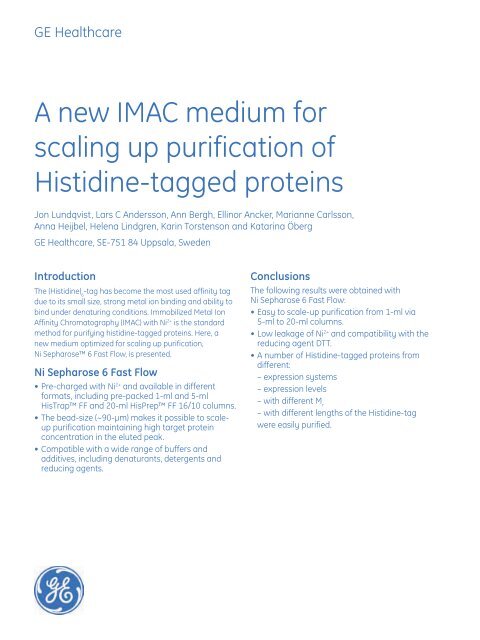
![[PDF] マニュアル GradiFrac](https://img.yumpu.com/22037825/1/190x253/pdf-gradifrac.jpg?quality=85)
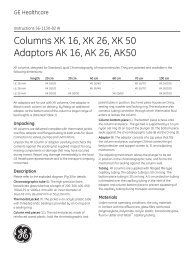
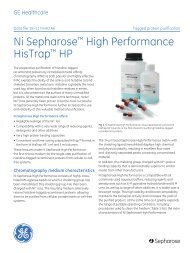
![[PDF] Sample preparation for analysis of protein, peptides and ...](https://img.yumpu.com/21549715/1/190x257/pdf-sample-preparation-for-analysis-of-protein-peptides-and-.jpg?quality=85)
![[PDF] Data File: rProtein A Sepharose Fast Flow](https://img.yumpu.com/21549316/1/190x253/pdf-data-file-rprotein-a-sepharose-fast-flow.jpg?quality=85)
![[PDF] MBP-tagged protein purification](https://img.yumpu.com/21548507/1/184x260/pdf-mbp-tagged-protein-purification.jpg?quality=85)
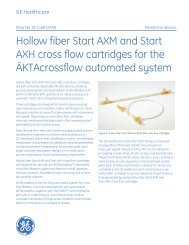
![[PDF] AKTA ready system Data file](https://img.yumpu.com/21540925/1/190x253/pdf-akta-ready-system-data-file.jpg?quality=85)
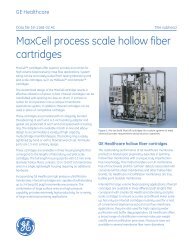
![[PDF] Data File - rProtein A/Protein G GraviTrap](https://img.yumpu.com/21539052/1/190x253/pdf-data-file-rprotein-a-protein-g-gravitrap.jpg?quality=85)
